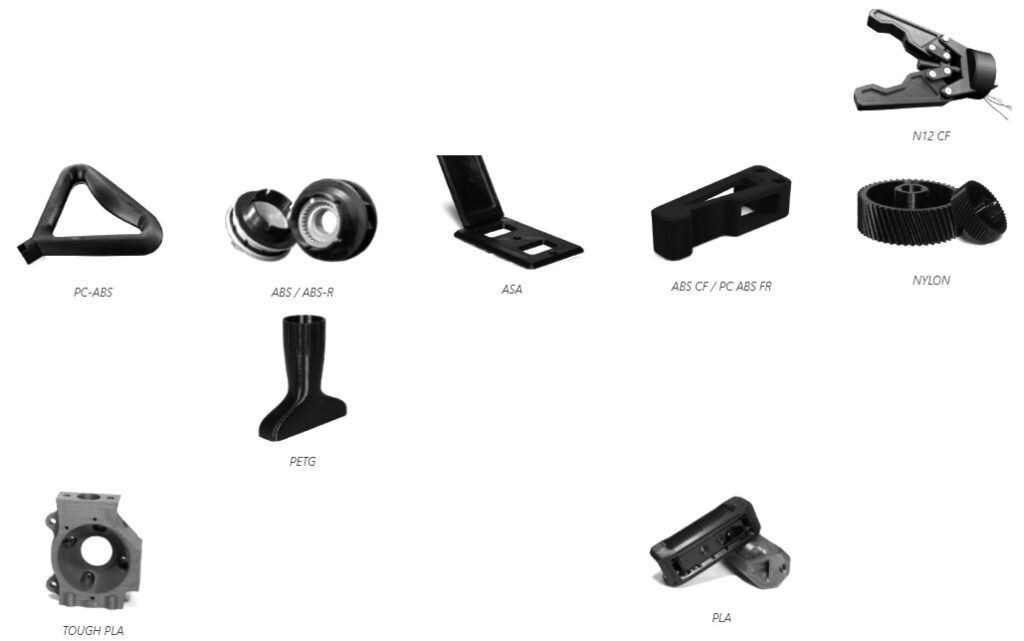Choosing a material for your needs
Carbon Fiber composites
| Nylon 6/66 CF | the greatest resistance to elevated temperatures and impact, this famous compound of the polyamide has the best parameters |
| Nylon N12 CF | when the finish is more important and without the need for post-processing, sacrificing some parameters |
| ABS CF | superior rigidity to the original material that makes it an end-use part |
| PETG CF | adding carbon fibers, increasing its rigidity, multiplies its applications |
ABS and ASA composites
| ABS ESD | when we need to protect elements from electrostatic discharges |
| ABS – KEVLAR | the use of aramid fibers as additive gives it high impact resistance |
| ABS EC | carbon nanotubes give it electrical conductivity |
| ABS + PC | these polymers mix confers an improvement in the characteristics of ABS* |
| ABS + PC – FR | with remarkably rigidity and flame-retardant, perfect in automotive, railway and aerospace* |
| ABS | of course, in its pure state, the polymer with an excellent finish and perfect in prototypes. |
| ASA | like ABS but with high resistance to UV and humidity, perfect for outdoors |
Composites en PC
| PC – PBT | these polymers mix provides exceptional climatic resistance, highly appreciated in the automotive industry. |
| PC FR | installations where the use of flame-retardant materials is required |
| PC + PMMA | these two polymers combine high transparency and rigidity, perfect for use in luminaires |
| PC + ABS | this polymers mix confers improved characteristics of polycarbonate* |
| PC + ABS – FR | with remarkably rigidity and flame-retardant, perfect in automotive, railway and aerospace* |
| PC | and of course, pure resin, with acceptable rigidity and also the possibility of high transparency |
Technical materials
| Nylon: | excellent abrasion resistance and elevated temperature resistance | |
| PETG ESD: | the PETG versatility with protection against electrostatic discharges | |
| PETG: | a significant improvement over the well-known PET and with the ability to contain liquids | |
| TPE: | this is a perfect elastomeric product, like rubber, where rigidity is not important (TPU) | |
| PLA: | obtained from corn, biodegradable*, the best known and easy to work with, but excellent resistance | |
| TOUGH PLA: | PLA modification that has better resistance to tension |
Visual summary of the two most important characteristics and most valued in a polymer or composite
- From left to right implies from smallest to LARGEST strength.
- From top to bottom implies HIGHER to Least heat deflection.

There are clear preferences for use in different industrial sectors:
- AUTOMOTIVE: on external parts PC-PBT and ASA; PC-ABS interiors and PETG-CF and Nylon-CF engine parts
- ELECTRONICS: electronic components containers in ABS-ESD, ABS-EC, PETG-ESD
- LABORATORY: custom containers in PETG, ABS, TPU
- NAUTICAL: exposed to adverse conditions and high resistance such as Nylon-CF, ASA, ABS-Kevlar, PC-PBT
- AEROSPACE: light and reliable such as Nylon-CF, PC-ABS, PC-PBT, ABS-CF, PEEK
- ENGINEERING AND TESTING: end-use parts such as ABS, ASA, PC-ABS
Other Engineering Grade Materials*
More sophisticated Polymers and Composites with Fiberglass, some with antimicrobial characteristics such as Graphene, are now available for FDM production. * under project study
| ABS-S | certified for food contact thanks to its additive, also in PC and PEBA PC |
| ABS ABV | antimicrobial properties, thanks to Graphene oxide, perfect in medicine; also in TPU |
| ABS NEO | thanks to the Graphene Nanotubes gives a characteristic resistance, also in TPU |
| PA6 GF30 | the famous polyamide reinforced with fiberglass, also in PC and PP |
| otros: | HIPS, PEEK, PEBA, PPS... also in their RECYCLED versions. |

